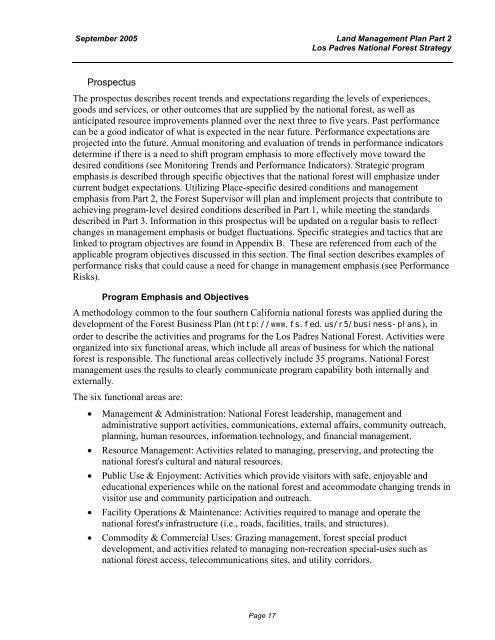Land Management Plan - Part 2 Los Padres National Forest Strategy
Land Management Plan - Part 2 Los Padres National Forest Strategy
Land Management Plan - Part 2 Los Padres National Forest Strategy
You also want an ePaper? Increase the reach of your titles
YUMPU automatically turns print PDFs into web optimized ePapers that Google loves.
September 2005 <strong>Land</strong> <strong>Management</strong> <strong>Plan</strong> <strong>Part</strong> 2<br />
<strong>Los</strong> <strong>Padres</strong> <strong>National</strong> <strong>Forest</strong> <strong>Strategy</strong><br />
Prospectus<br />
The prospectus describes recent trends and expectations regarding the levels of experiences,<br />
goods and services, or other outcomes that are supplied by the national forest, as well as<br />
anticipated resource improvements planned over the next three to five years. Past performance<br />
can be a good indicator of what is expected in the near future. Performance expectations are<br />
projected into the future. Annual monitoring and evaluation of trends in performance indicators<br />
determine if there is a need to shift program emphasis to more effectively move toward the<br />
desired conditions (see Monitoring Trends and Performance Indicators). Strategic program<br />
emphasis is described through specific objectives that the national forest will emphasize under<br />
current budget expectations. Utilizing Place-specific desired conditions and management<br />
emphasis from <strong>Part</strong> 2, the <strong>Forest</strong> Supervisor will plan and implement projects that contribute to<br />
achieving program-level desired conditions described in <strong>Part</strong> 1, while meeting the standards<br />
described in <strong>Part</strong> 3. Information in this prospectus will be updated on a regular basis to reflect<br />
changes in management emphasis or budget fluctuations. Specific strategies and tactics that are<br />
linked to program objectives are found in Appendix B. These are referenced from each of the<br />
applicable program objectives discussed in this section. The final section describes examples of<br />
performance risks that could cause a need for change in management emphasis (see Performance<br />
Risks).<br />
Program Emphasis and Objectives<br />
A methodology common to the four southern California national forests was applied during the<br />
development of the <strong>Forest</strong> Business <strong>Plan</strong> (http://www.fs.fed.us/r5/business-plans), in<br />
order to describe the activities and programs for the <strong>Los</strong> <strong>Padres</strong> <strong>National</strong> <strong>Forest</strong>. Activities were<br />
organized into six functional areas, which include all areas of business for which the national<br />
forest is responsible. The functional areas collectively include 35 programs. <strong>National</strong> <strong>Forest</strong><br />
management uses the results to clearly communicate program capability both internally and<br />
externally.<br />
The six functional areas are:<br />
• <strong>Management</strong> & Administration: <strong>National</strong> <strong>Forest</strong> leadership, management and<br />
administrative support activities, communications, external affairs, community outreach,<br />
planning, human resources, information technology, and financial management.<br />
• Resource <strong>Management</strong>: Activities related to managing, preserving, and protecting the<br />
national forest's cultural and natural resources.<br />
• Public Use & Enjoyment: Activities which provide visitors with safe, enjoyable and<br />
educational experiences while on the national forest and accommodate changing trends in<br />
visitor use and community participation and outreach.<br />
• Facility Operations & Maintenance: Activities required to manage and operate the<br />
national forest's infrastructure (i.e., roads, facilities, trails, and structures).<br />
• Commodity & Commercial Uses: Grazing management, forest special product<br />
development, and activities related to managing non-recreation special-uses such as<br />
national forest access, telecommunications sites, and utility corridors.<br />
Page 17
















